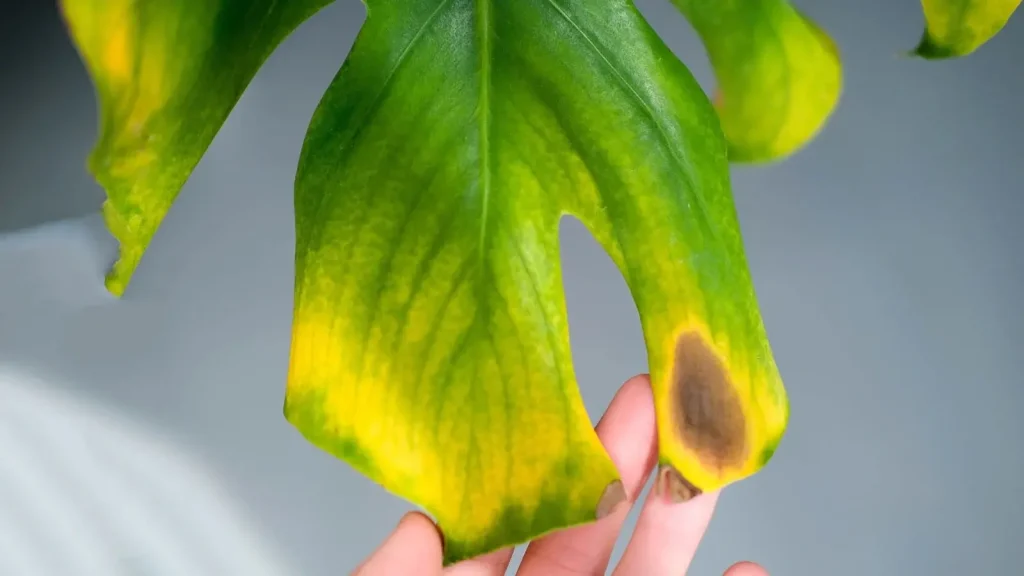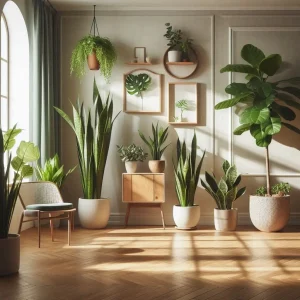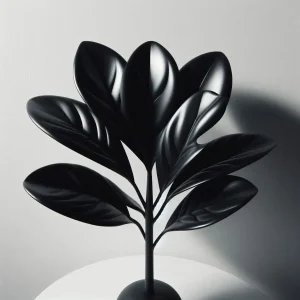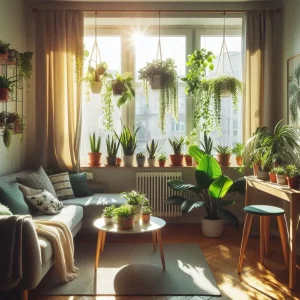The reason for the brown coloration of the leaves of indoor plants is a question that deeply concerns those who love and care for plants. Surely, anyone who has delved into the realm of plant care has encountered the issue of their plant’s leaves turning brown and dry in various areas such as leaf tips, entire leaves, margins, lower or upper leaves, and so forth. There are numerous reasons behind this phenomenon, and in this article, we intend to shed light on some of them. In general, it is recommended that if the damage is minor, only the dry portion should be removed, but if the damage is severe, the entire leaf should be carefully trimmed to prevent any harm to the stem. Join us as we explore the reasons behind the browning of indoor plant leaves.
| Factor | Effect on Indoor Plants |
| Excessive use of fertilizers | Leaf burning, excessive salt buildup in soil |
| Root rot and crown rot | Browning of leaves due to fungal infection in roots |
| Lack of sufficient root space | Restricted water absorption, leading to leaf browning |
| Excessive salt in soil | Leaf browning due to salt buildup in soil |
| Diseases and pests | Browning of leaves due to insect infestations or diseases |
| Warm, dry air and low humidity | Uneven moisture distribution, causing lower leaves to dry out |
| Overwatering | Root rot, leading to leaf browning and wilting |
| Underwatering | Leaf drying and browning due to dehydration |
| Age of the plant | Natural shedding of lower leaves, leading to browning |
| Insufficient light or excessive light | Leaf burning or browning due to inadequate or excessive light exposure |
The reason for the browning of leaves in indoor plants and ways to remedy it are as follows:
Under what conditions will the browning of leaves in indoor plants be due to watering?
Page Contents
ToggleDry, brown, and brittle leaf tips are signs of a thirsty plant and insufficient watering. However, overwatering or inadequate drainage in the pot can also lead to this condition! This phenomenon occurs because overwatering damages the roots and prevents the plant from absorbing water, resulting in the plant showing signs of dehydration and thirst.
To solve this problem, you should stop watering the plant. Additionally, in this situation, check the drainage hole under the pot, and if it’s clogged, open it up.
To ensure proper drainage, it is important to make sure that excess water drains out from under the pot after watering. Additionally, to lighten the soil, you can add some sand or perlite to it.
read more: Adding Calcium to Soil: everything you need to know
If the water used for irrigation is contaminated, what should we do?
Sometimes the amount of watering is correct, but the water used for irrigation is contaminated.
To address this issue, it is recommended to separate the dry and brown leaves from your plant and water it regularly.
Furthermore, you can also use a clean pair of scissors to trim them from within the browned area.
Note:
Just be careful not to cut into the green parts of your plant; otherwise, new brown spots will emerge.
If the entire root system of your plant has been compromised, separate the roots from the plant as far as the dried portion extends, then try to propagate the plant again through rooting or any other means.
Under what conditions will excessive light or direct sunlight cause browning of indoor plant leaves?
Sometimes direct sunlight (or misting plants in direct sunlight) can cause dry brown spots on the leaves.
In this case, avoid placing the plant in direct sunlight and misting it under these conditions.
Does the age of the plant cause browning of indoor plant leaves?
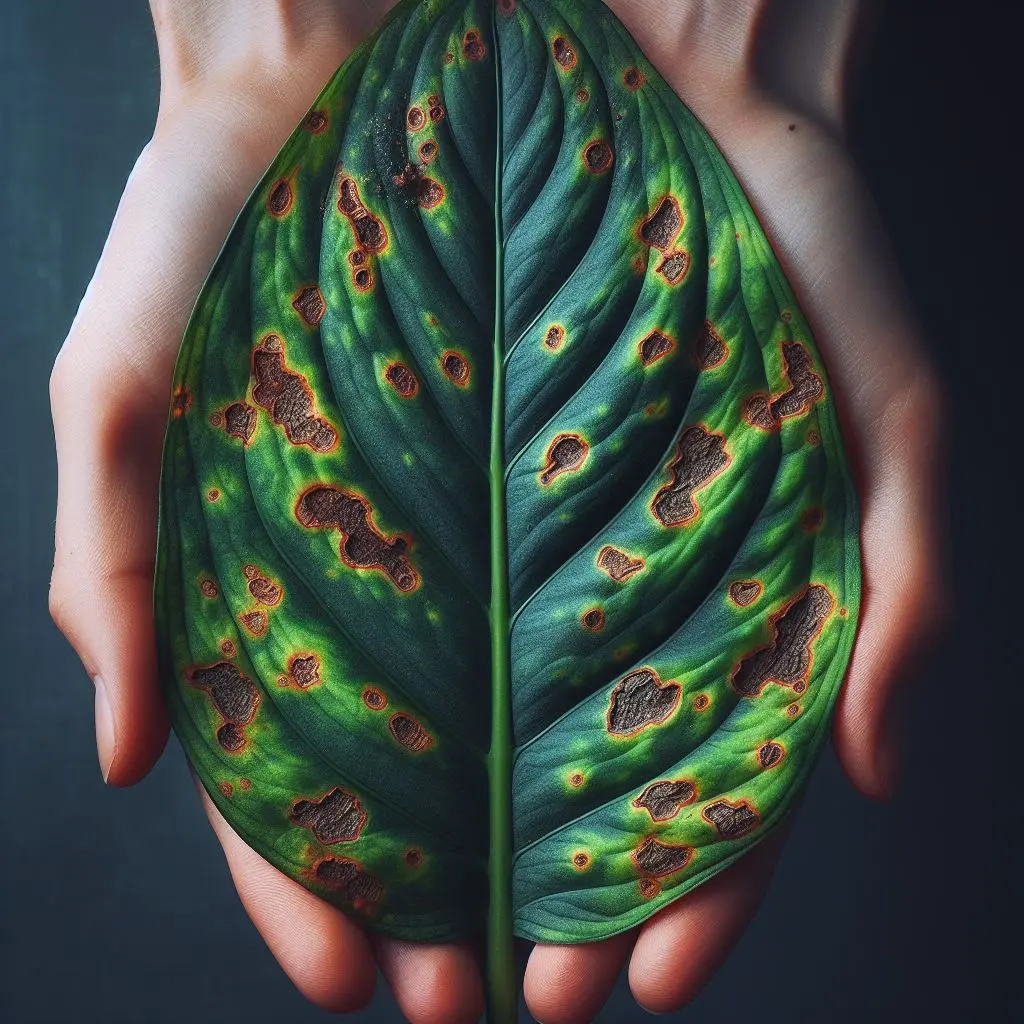
The lower leaves of some plants naturally dry up and fall off as they age.
If you are sure that leaf shedding is solely due to aging and there is no other reason, the only thing you need to do is to remove the dry leaves from the plant.
How does soil nutrient deficiency lead to browning of indoor plant leaves?
The deficiency of certain soil elements can result in burning at the tips or margins of the leaves (for example, potassium deficiency often causes this). Plants suffering from potassium deficiency are usually weak, stunted, and small. In these plants, the growth of the main stem and branches is halted, and the distance between nodes becomes shorter. In severe cases of deficiency, the plant’s branches will start to dry up from the tips. Proper fertilization can also address this issue.
Can excessive use of fertilizers cause browning of indoor plant leaves?
Burning at the margins and tips of leaves is mostly due to excessive use of fertilizers. If the soil becomes crumbly and compacted, it indicates saturation with fertilizer, causing soil suffocation. Most plants require minimal fertilization (or no fertilization at all) during the winter, and when fertilizers are applied excessively, the excess remains stored in the plant, leading to leaf burning.
How can root rot and crown rot cause browning of indoor plant leaves?
Sometimes, due to excessive watering, the roots of the plant can suffer from fungal rot, which manifests symptoms in its leaves.
In this case, remove the plant from its pot, trim the browned parts, treat the remaining roots with sulfur, and replant it in a new pot with fresh soil.
Can the lack of sufficient space for roots also cause browning of indoor plant leaves?
If there is insufficient space in the pot for the roots, the plant cannot absorb enough water.
Therefore, it is recommended to repot the plant (appropriate to its size) to ensure adequate root space.
Can the presence of excessive salt in the soil also lead to browning of indoor plant leaves?
Salt may exist naturally in the soil or deposit due to excessive fertilization, leading to leaf browning.
To prevent this issue, it’s best to use sterilized soil and salt-free water for your plants.
Can diseases and pests cause browning of indoor plant leaves?
Yes, brown spots appearing in the middle of the leaves are often due to insect infestations or diseases.
Various pests such as worms, mealybugs, spider mites, and aphids are among the most common pests that can attack indoor plants.
Fungi and bacteria can also attack the roots and leaves of your plant, causing it to turn yellow and dry.
When such a problem arises, separate the infected stems and leaves.
In case of severe infestation, it is advisable to discard the plant as these pests and diseases spread rapidly throughout your plant.
You can also use insecticides or fungicides. Before spraying, it is better to first remove the infected and dried branches and leaves of your plant.
After spraying, give your plant some time to eliminate the pests and regularly check it to ensure that the pests are decreasing.
Can warm, dry air and lack of humidity cause browning of indoor plant leaves?
Yes, some plants require higher humidity levels than the typical ambient humidity, and if the air is too dry, their leaves may begin to dry out (especially if the plant is exposed to direct and intense sunlight).
In winter, the operation of heaters and furnaces can indeed dry the air and reduce the humidity in the house. Some plants also tend to grow downward, and in their growth process, they shed their lower leaves. In this situation, humidity may not be evenly distributed among the leaves, leading to dryness and wilting of the lower leaves.
Read CityPlant‘s Nutrient Deficiency Quote:
If you have had your plant for more than one year and have not used any plant food, your plant might be struggling with a lack of nutrients. We offer amazing plant food full of nutrients and very gentle on the plant’s roots.

